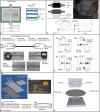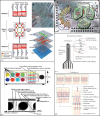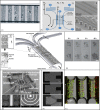Microfluidic devices for cell cultivation and proliferation
- PMID: 24273628
- PMCID: PMC3829894
- DOI: 10.1063/1.4826935
Microfluidic devices for cell cultivation and proliferation
Abstract
Microfluidic technology provides precise, controlled-environment, cost-effective, compact, integrated, and high-throughput microsystems that are promising substitutes for conventional biological laboratory methods. In recent years, microfluidic cell culture devices have been used for applications such as tissue engineering, diagnostics, drug screening, immunology, cancer studies, stem cell proliferation and differentiation, and neurite guidance. Microfluidic technology allows dynamic cell culture in microperfusion systems to deliver continuous nutrient supplies for long term cell culture. It offers many opportunities to mimic the cell-cell and cell-extracellular matrix interactions of tissues by creating gradient concentrations of biochemical signals such as growth factors, chemokines, and hormones. Other applications of cell cultivation in microfluidic systems include high resolution cell patterning on a modified substrate with adhesive patterns and the reconstruction of complicated tissue architectures. In this review, recent advances in microfluidic platforms for cell culturing and proliferation, for both simple monolayer (2D) cell seeding processes and 3D configurations as accurate models of in vivo conditions, are examined.
Figures






References
-
- Squires T. M. and Quake S. R., “ Microfluidics: Fluid physics at the nanoliter scale,” Rev. Mod. Phys. 77, 977–1026, 2005.10.1103/RevModPhys.77.977 - DOI
-
- Ho C. M. and Tai Y. C., “ Micro-electro-mechanical-systems (MEMS) and fluid flows,” Annu. Rev. Fluid Mech. 30, 579–612 (1998).10.1146/annurev.fluid.30.1.579 - DOI
Publication types
LinkOut - more resources
Full Text Sources
Other Literature Sources
